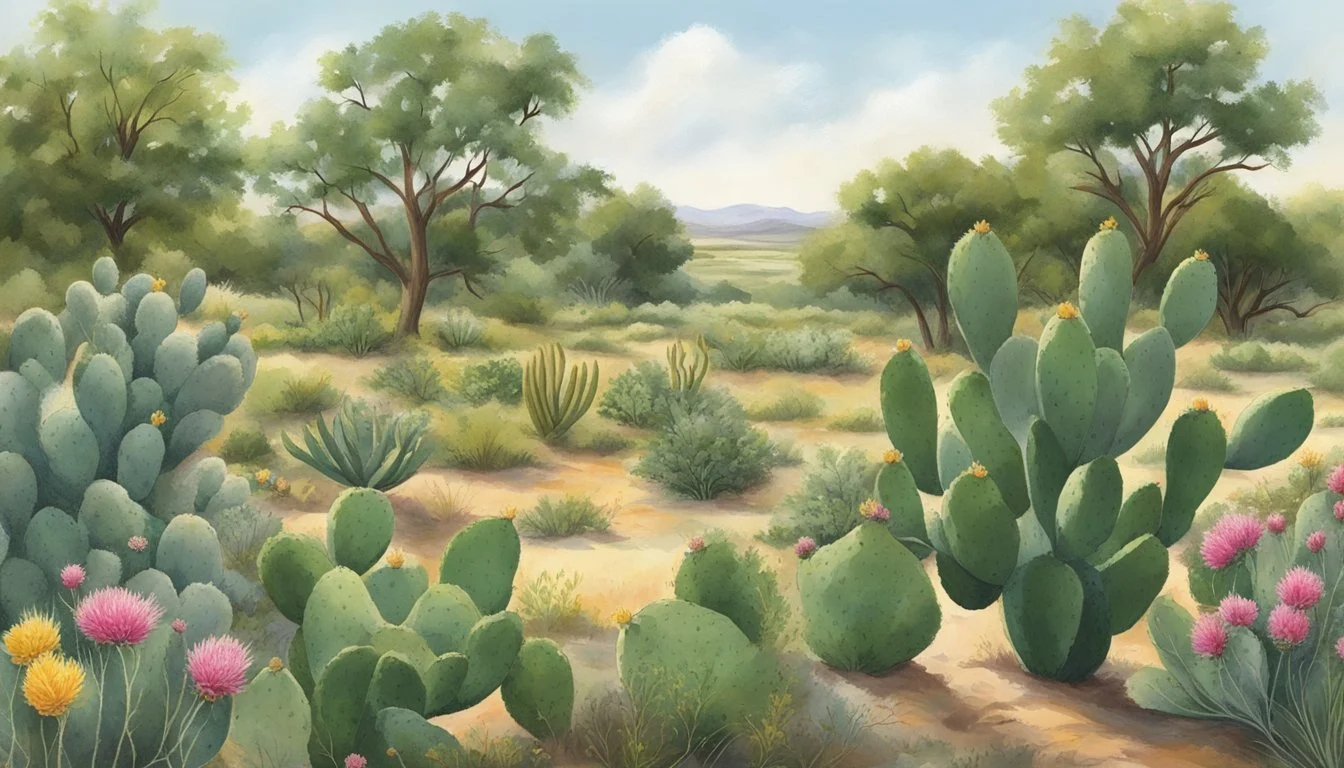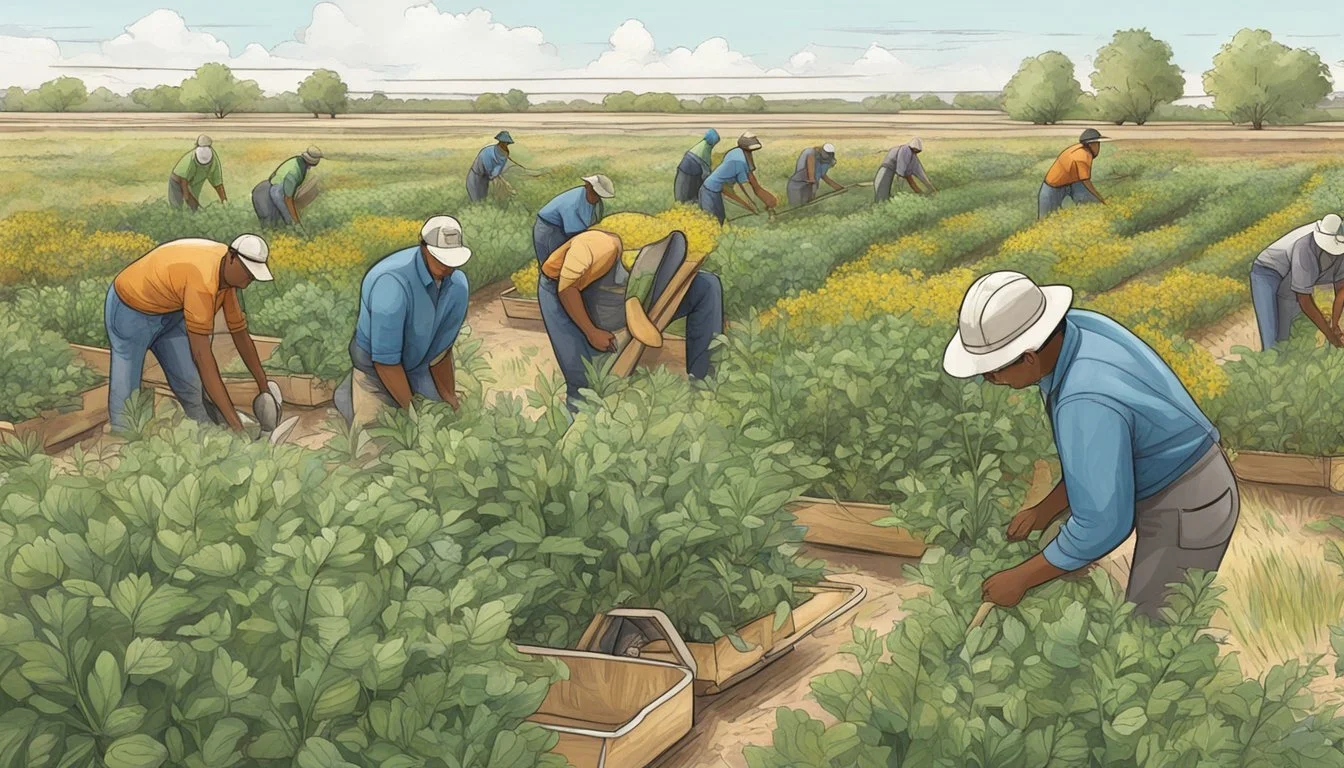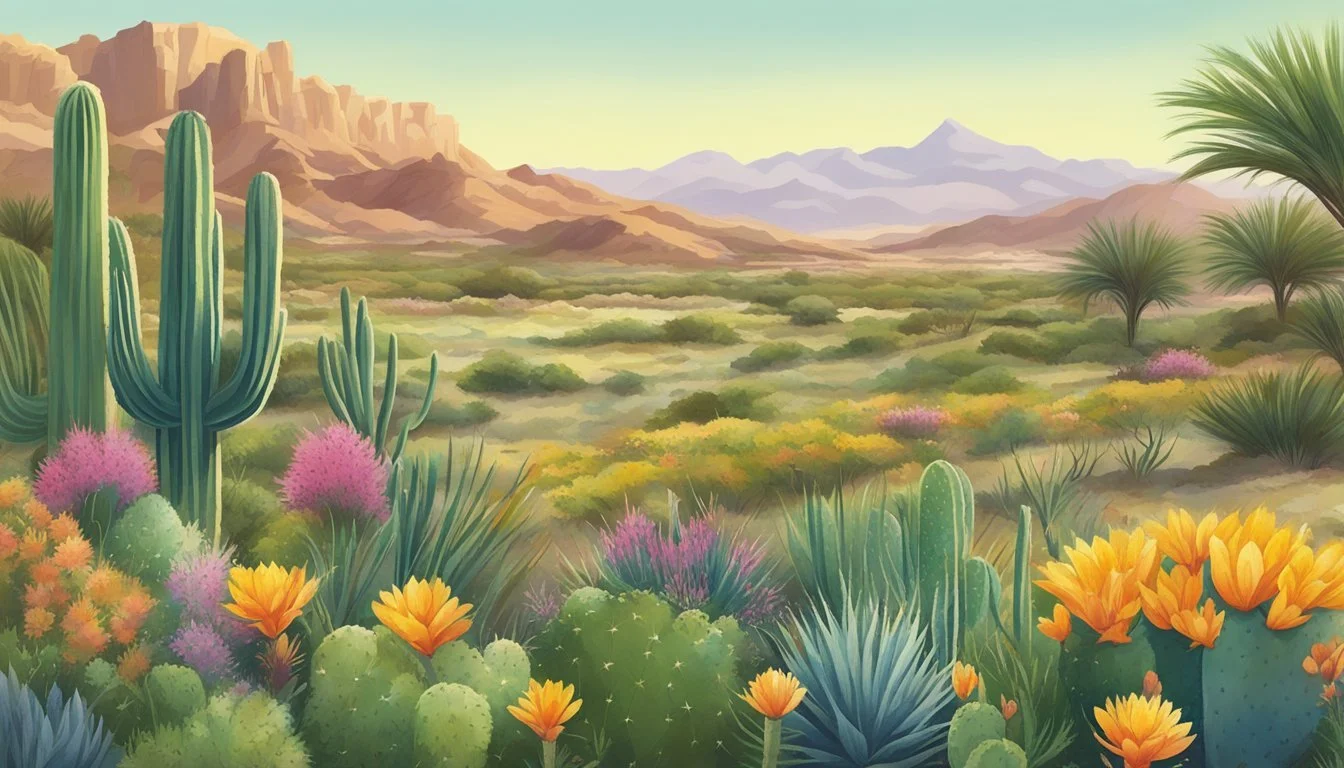Southern Plains Native Edible Plants
A Guide to Traditional Foods
Discover the rich array of native edible plants that grace the Southern Plains, perfect for both foraging enthusiasts and home gardeners alike. Among these native gems, the fragrant sumac (Rhus aromatica) stands out with its trifoliate leaves and minimal water requirements, making it an ideal candidate for sustainable landscapes. This perennial shrub, thriving in full sun or partial shade, reaches heights of 3 to 6 feet, offering both beauty and utility.
Foraging across the Southern Plains reveals an abundance of native fruits in old fields and open woods. The region is home to plums, cherries, and currants, each providing unique flavors and nutritional benefits. Integrating these fruits into one's diet not only fosters a connection to the land but also supports local ecosystems and biodiversity.
The diverse palette of native plants also includes edible berries and herbs that have adapted beautifully to the area's climate. These plants not only contribute to a sustainable food source but also enhance the resilience of local landscapes against changing environmental conditions. By exploring and cultivating these native edible plants, individuals can enjoy a more sustainable, nutritious, and ecologically harmonious lifestyle.
Historical Context
The history of edible plants in the Southern Plains is rich with knowledge passed down through generations. Indigenous peoples utilized a variety of plants not only for sustenance but also for medicinal purposes and survival.
Indigenous Peoples' Traditional Knowledge
Indigenous communities of the Southern Plains have extensive knowledge of native plants. For thousands of years, they identified, cultivated, and harvested plants such as sunflowers, which were a key food source.
These plants provided sustenance and variety in their diets during times of scarcity. The sunflower, in particular, valued for its seeds, was widely used by native tribes long before its popularity as a snack.
Other notable edible plants include lambsquarters, known for their nutritious leaves, often cooked with salt and butter.
History of Foraging in the Southern Plains
The foraging history in the Southern Plains dates back to the end of the Pleistocene. Indigenous peoples relied heavily on wild plants alongside hunting practices.
Foraging was not merely a supplementary activity but a crucial part of their economy and survival. Despite historical descriptions often emphasizing bison hunting, plant foraging played an equally vital role.
Bison remains dominate archaeological sites, but evidence of diverse plant use indicates a balanced diet. This foraging tradition reflects a deep connection and understanding of the Prairie's natural resources.
Fundamentals of Foraging
Foraging for native edible plants in the Southern Plains requires knowledge of foraging basics, adherence to legal guidelines, and the ability to accurately identify edible plants.
Foraging Basics and Ethics
Foraging begins with understanding the local ecosystem and knowing which plants are safe to consume. It is crucial to avoid over-harvesting to maintain ecological balance. Always collect small quantities and leave enough for wildlife and plant reproduction.
Ethical foraging also means respecting the land and any property permissions. Minimize environmental impact by sticking to established paths and avoiding trampling sensitive areas. Educate yourself about invasive species and avoid spreading them inadvertently.
Leave no trace practices include cleaning up any litter and not causing harm to the environment. These principles ensure that foraging activities are sustainable and respectful.
Legal Guidelines and Permission
Familiarize yourself with local regulations regarding foraging. Certain areas, particularly state and national parks, have restrictions. Always check for posted signs and rules.
Before foraging on private property, obtain explicit permission from the landowners. Trespassing laws can result in fines or legal action, so communication with landowners is essential.
Some regions may require permits for harvesting specific plants, especially those that are rarer or under conservation protection. Ensure you have all necessary documentation before beginning your foraging activities.
Identifying Edible Plants
Accurate plant identification is crucial to safe foraging. Misidentifying plants can lead to the collection of poisonous species. Investing in a reliable field guide and utilizing online resources can aid in identification.
Focus on learning about key native plants in the Southern Plains, such as the sand plum, pawpaw, and wild onion. Understanding their distinctive features, such as leaf shape, flower color, and habitat, helps ensure correct identification.
Joining a guided tour or workshop can enhance skills and provide practical experience. Engaging with local foraging communities and experts also offers valuable insights and confirmation of plant identities.
Edible Plant Profiles
The Southern Plains offer a rich diversity of native edible plants. These plants provide various parts that can be foraged, from berries and roots to leafy greens and herbs, each with unique characteristics and culinary uses.
Berries
Muscadine grapes (Vitis rotundifolia) are a prized native fruit. Found in the wild and cultivated, these berries are known for their thick skin and musky flavor. They can be eaten fresh or used for jellies, wines, and juices. The best-known variety is the Scuppernong.
Another notable berry is the American cranberry (Vaccinium macrocarpon). Native to northeastern North America, these berries thrive in acidic, moist soil. They are both flavorful and nutritious, used in sauces, baked goods, and juices. Cultivation requires a cooler climate and consistent root moisture.
Roots and Tubers
Jerusalem artichoke (Helianthus tuberosus) is a sunflower native to the Southern Plains. Its tubers are edible, offering a crisp texture with a nutty flavor. These tubers can be roasted, sautéed, or eaten raw in salads. They are also a good source of dietary fiber.
Arrowhead (Sagittaria latifolia), also known as duck potato, produces tubers that are a traditional food source. These tubers can be boiled, roasted, or dried and ground into flour. They grow in wetlands, making them accessible in marshy areas throughout the region.
Leafy Greens and Herbs
Pokeweed (Phytolacca americana) provides young shoots and leaves that can be cooked and eaten as greens. It is crucial to only harvest young plants as older ones can be toxic. Boiling the greens in several changes of water removes any harmful compounds.
Wild onion and garlic (Allium canadense) are wild relatives of common kitchen staples. Their leaves and bulbs can be used just like cultivated onions and garlic. They grow in grassy areas and are easily identified by their familiar onion-like smell.
Stinging nettle (Urtica dioica) offers leaves that, when cooked, are rich in vitamins and minerals. Though handling requires care due to its stinging hairs, nettle leaves are excellent in soups, teas, and as steamed greens.
Nutritional and Medicinal Benefits
Native edible plants in the Southern Plains offer significant nutritional and medicinal advantages. They are rich in essential vitamins and minerals, and many possess potent medicinal properties that have been used historically for various health purposes.
Vitamins and Minerals
The persimmon, a native fruit to the region, is an excellent source of vitamin C, vitamin A, and vitamin E. These vitamins support immune function and skin health. The high fiber content in persimmons aids digestion and promotes a healthy gut.
Sumac berries, another native plant, are packed with antioxidants and vitamin C. These nutrients can help combat oxidative stress and boost the immune system. Fragrant sumac is also known to be rich in tannins, which can improve oral health by reducing inflammation.
Goldenrod and dandelions, common across the Southern Plains, are full of vitamins A, C, and K, as well as potassium and iron. These nutrients support everything from bone health to cardiovascular function. Spiderwort contains significant levels of vitamin A and calcium, which are essential for vision and bone health.
Medicinal Properties of Native Flora
Elderberries are well-regarded for their immune-boosting properties due to their high levels of antioxidants, including flavonoids. They have been used traditionally to treat cold and flu symptoms. Elderberry syrup is a popular remedy during the flu season.
Goldenrod is known for its anti-inflammatory and diuretic properties. It has been used to treat urinary tract infections and reduce inflammation in the body.
Dandelions are not just nutritious; they also possess numerous medicinal benefits such as liver detoxification and improved digestion. The root is often used in herbal teas for its diuretic effect, helping the body eliminate excess fluids.
Spiderwort has been used in traditional medicine to treat minor wounds and insect bites, thanks to its anti-inflammatory and antimicrobial properties. The sap from the plant can be applied to affected areas to promote healing and reduce infection risk.
These native plants harness powerful combinations of nutrients and medicinal properties, making them invaluable resources for health and wellness in the Southern Plains.
Responsible Harvesting Practices
Responsible harvesting practices are essential to ensure that native edible plants in the Southern Plains continue to thrive. Key points include sustainable foraging techniques and strategies to prevent overharvesting and habitat damage.
Sustainable Foraging Techniques
Sustainable foraging involves collecting plants in a way that does not negatively impact the local ecosystem. One key practice is identifying and understanding plant life cycles. Only harvest plants when they are abundant and mature enough to withstand removal.
Another technique is rotational foraging. This means not harvesting from the same location repeatedly, which allows plant populations to recover. Maintaining a diverse plant selection in foraging helps ensure no single species is overly depleted.
Harvesting tools should be used properly to minimize damage. For instance, use clean and sharp tools to make precise cuts, reducing harm and promoting quicker recovery of the plant. Avoiding root harvesting is also crucial for perennials, as uprooting can permanently damage the habitat.
Preventing Overharvesting and Habitat Damage
Preventing overharvesting is critical to the longevity of native plant populations. Adhering to the "leave no trace" principle helps maintain the integrity of the foraging site. This means ensuring that the area looks undisturbed after you leave.
Respecting legal guidelines and local regulations concerning the harvest of native plants is also necessary. Many regions have laws to protect endangered species and delicate ecosystems from overharvesting.
Educating others about responsible foraging practices can further protect these habitats. Sharing knowledge on how to forage sustainably can reduce the overall impact on the environment.
Finally, always be mindful of the broader ecosystem. Avoid trampling across sensitive areas and disturbing wildlife habitats. Responsible foraging ensures that native edible plants will be available for future generations to enjoy.
Edibles in the Ecosystem
Native edible plants in the Southern Plains are integral to both wildlife and the health of local ecosystems. They provide food for various species and help maintain ecological balance.
Interactions with Wildlife
Wild plants such as prickly pear cactus and muscadine provide essential nourishment for many animals. Prickly pear cactus, with its juicy pads and fruit, serves as a vital food source for deer and rodents.
Birds, including species like quail and dove, feast on the berries and seeds of these plants. Similarly, nuts from native trees such as pecans fuel the diet of squirrels and other small mammals. This mutual relationship supports the survival of these animals, especially in the harsher climates of the Southern Plains.
Role in Native Ecosystems
These edible plants play a crucial role in sustaining the ecosystem's health. Flora such as Allium canadense (wild onion) not only contributes to the biodiversity of the area but also enriches the soil with essential nutrients as they break down.
In desert areas, plants like desert willow create microhabitats that protect smaller plants from intense sunlight. Forests also benefit from native edibles, which enhance soil structure and prevent erosion. The intricate web of relationships among these plants, their environment, and the wildlife ensures that the Southern Plains remain a thriving and balanced ecosystem.
Culinary Applications
Using Southern Plains native edible plants in cooking offers unique flavors and nutritional benefits. These plants include a variety of fruits and herbs that can be used in diverse dishes.
Cooking with Native Plants
Wild onions add a robust flavor to soups and stews. Sand plums, also known as Chickasaw plums, have a tart taste perfect for making sauces and syrups. The Pawpaw fruit, with its custard-like texture, is excellent in desserts like pies and puddings.
Lamb’s quarter can be sautéed as a nutritious side dish. Cattail stalks offer a crunchy texture and can be cooked similar to asparagus. These ingredients enhance the culinary repertoire of any kitchen while also emphasizing local and sustainable sourcing.
Recipes and Preservation Methods
Sand plums can be used to make delicious jams, jellies, and even wine. To make a basic sand plum jam:
Combine 4 cups of sand plums with 1 cup of water.
Cook until the fruit softens, then add 3 cups of sugar.
Continue cooking until the mixture thickens.
The Pawpaw fruit can be pureed and frozen for use in smoothies or baked goods. Wild onions can be dried or pickled to use as seasoning throughout the year. Lamb’s quarter can be blanched and frozen, retaining its nutrients and making it easy to add to winter soups. Herbal teas made from local plants like cattail or sage provide flavorful, healthful beverage options.
Practical Foraging Tips
Effective foraging in the Southern Plains requires both the right equipment and an understanding of safety measures to avoid poisonous plants. Proper preparation ensures not only a successful harvest but also a safe experience.
Equipment and Tools
When foraging, having the right tools is essential. A sturdy backpack can hold gathered plants and equipment. Garden gloves protect hands from thorns and stings. A small knife or scissors helps in cutting herbs, berries, and other edible plants.
A field guide specific to Southern Plains edible plants is highly recommended for accurate identification. A magnifying glass can be useful for examining plant details closely. Don't forget a notebook and pen to document findings and locations.
Clothing should be durable and long-sleeved to protect against scratches and insect bites. Having a water bottle ensures the forager stays hydrated during excursions. A small first-aid kit can be crucial for treating minor injuries that may occur.
Safety Measures Against Poisonous Plants
Proper plant identification is critical to avoid poisoning. Begin with familiar plants and progressively learn to identify new ones using multiple distinguishing features such as leaf shape, color, and texture.
Never consume a plant unless you are 100% sure of its identity. Many toxic plants have benign lookalikes. Common dangerous plants in the Southern Plains include poison ivy, poison oak, and various types of mushrooms.
Teach children not to touch unknown plants. Carry anti-itch creams to treat any accidental contact with poisonous plants. Awareness of emergency procedures is paramount in case of ingestion of a toxic plant, ensure to have local poison control numbers saved. Strict hygiene practices, such as washing hands thoroughly after handling plants, further enhance safety.
Plant Identification and Habitat Guide
Foraging in the Southern Plains requires a good understanding of plant characteristics and their specific habitats. Knowing how to identify common edible species and the conditions they thrive in is fundamental.
Characteristics of Common Edible Species
Identifying common edible plants in the Southern Plains involves examining their unique features:
Cattails (Typha latifolia):
Type: Herbaceous perennial
Identification: Long, flat leaves resembling blades of grass; dense, sausage-shaped flower spikes.
Edible Parts: Roots, stems, and pollen.
Amaranth (Amaranthus spp.):
Type: Annual
Identification: Broad leaves, with tiny, clustered flowers; typically red or green in color.
Edible Parts: Leaves, stems, seeds.
Dandelion (Taraxacum officinale):
Type: Perennial
Identification: Jagged leaves, bright yellow flowers turning into fluffy seed heads.
Edible Parts: Leaves, roots, flowers.
Habitat and Growth Conditions
Understanding the habitats where these plants thrive helps in locating them:
Cattails:
Habitat: Found near sources of water like ponds, streams, and wetlands.
Distribution: Common across Colorado, Utah, and New Mexico.
Amaranth:
Habitat: Prefers disturbed soils, often found in fields, gardens, and roadsides.
Distribution: Wide distribution in warmer climates, including the Southern Plains.
Dandelions:
Habitat: Grows in meadows, gardens, and along roadsides.
Distribution: Ubiquitous across North America, adaptable to various soil types.
Knowing where these plants grow and their distinctive characteristics ensures foragers can identify and harvest them safely.










